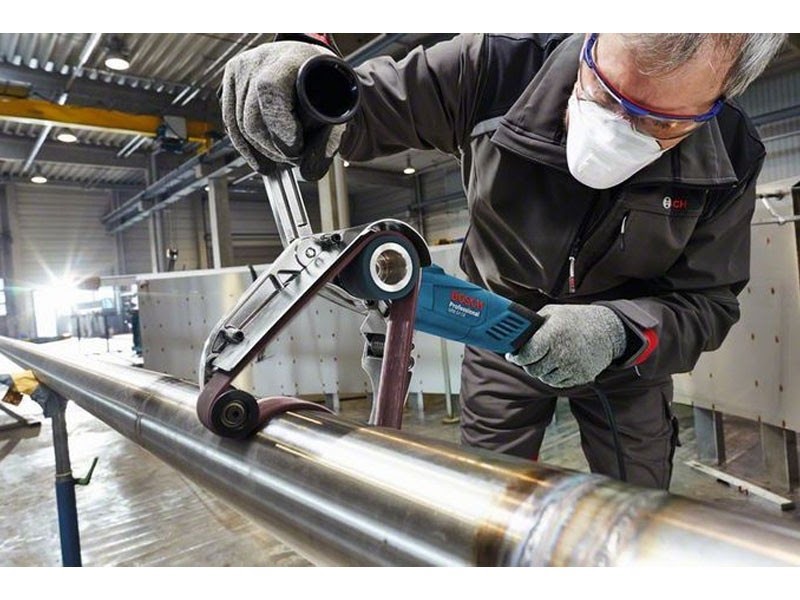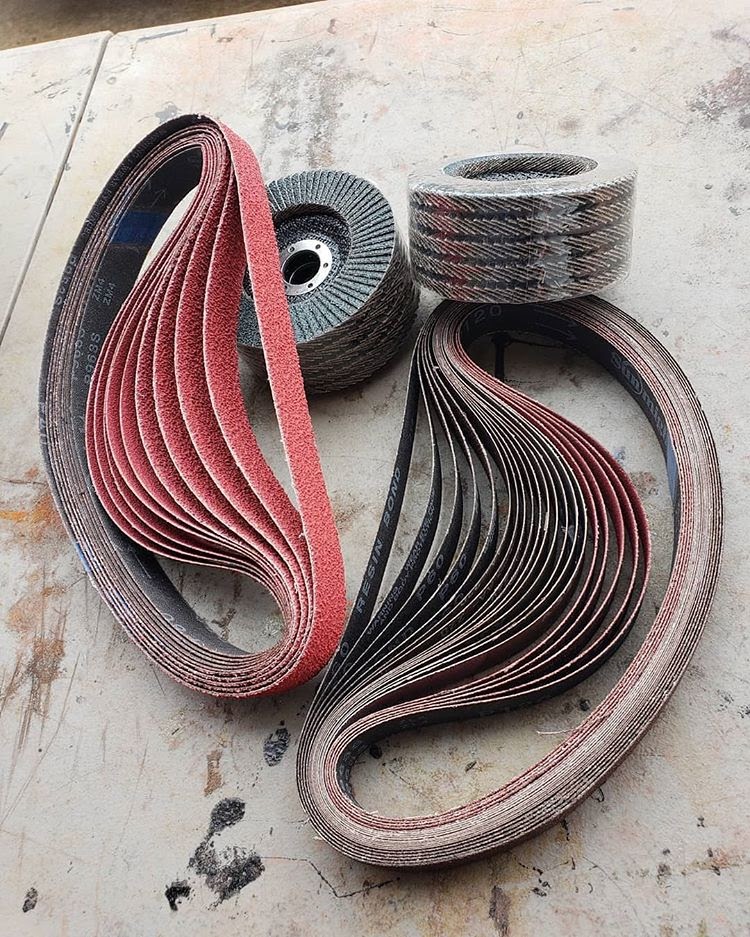
Since its invention, the belt sander has transformed the way in which people work with wood and metal. Thanks to this highly versatile tool, fabricators can quickly and efficiently work in a way that simply wasn't possible before its invention. Sanding belts have taken the hard work out of wood and metalwork, and allow users to perform huge amounts of sanding and grinding without even beginning to break a sweat.
Perhaps the most important, yet often the most overlooked, component of the belt sander are the abrasive sanding belts. This is the actual part of the belt sander that comes into contact with the workpiece to grind and scrape the layers away from the surface.
Choosing the right sanding belt is a challenge and more important than you may think, as failure to do so can cause damage to both the materials that you're working on as well as your belt sander. Getting one that's appropriate for the kind of work you're doing may be confusing when you look at the huge number of different kinds of sanding belts that are available on the market today. We've put together this comprehensive guide to help you get to the bottom of any difficult questions you may have and find the best sanding belts for the task at hand.
Quick Guide: How to Choose the Best Sanding Belt
- Determine your project type - What material will you be sanding (wood, metal, etc.) and what is your desired outcome (smoothing, shaping, finishing, etc.)?
- Identify the sanding machine you'll be using - What’s kind of belt sander will you be using? Handheld belt sander, stationary belt sander, or other types? Different machines require specific belt sizes and types.
- Choose the appropriate abrasive grain - Take into consideration the material you’re sanding and what kind of finish you want. Choose from options like aluminum oxide, zirconia, ceramic, silicon carbide, or non-woven based on the material and project goals.
- Select the right grit - Grit size determines coarseness. Choose between coarse (for material removal), medium (for general sanding), or fine (for finishing) grits.
- Consider the backing material - The backing material affects its flexibility and strength. Common backing materials include paper, cloth, and polyester. Each of these backing types also have their own “weights” with different features.
- Decide on the belt size - Choose a belt that is compatible with your belt sander.
What are Sanding Belts?
Okay, let’s just get the basics out of the way here. Sanding belts are the actual part of the belt sander that comes into contact with the workpiece to grind and scrape the layers away from the surface. They are a type of coated abrasive, constructed in a continuous loop which attaches to a machine belt grinder.
Types of Sanding Belt Abrasives
The rough surface on your sanding belt is made up of different types of abrasive grains. There are four main abrasive grains (plus a non-woven style), each with their own set of characteristics and plus points. Some best suited only for prep jobs, and some that work well with sanding metal.
Aluminum Oxide Sanding Belts:
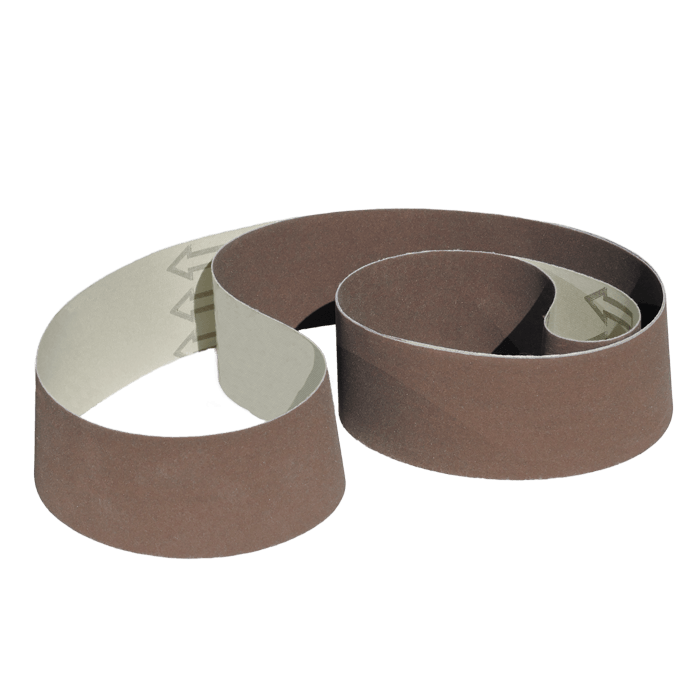
Aluminum oxide usually appears with a distinctive red / brown color that is arguably the most popular sanding belt for wood that's available on the market today. It's achieved this popularity by being so affordable, durable, and efficient at sanding wood as well as metal. Aluminum oxide sanding belts can be used on virtually any kind of sander to great effect. When manufactured from premium quality materials with a strong, durable backing, aluminum oxide sanding belts are guaranteed to produce professional results on a broad range of materials. This kind of belt is great for general purpose sanding.
Suitable For: Most Ferrous Metals (including cast iron, carbon steel, alloy steel, wrought iron), composites, plastics and wood
Recommended Usage: General use sanding/grinding and for budget conscious users
Zirconia (Zirc) Alumina Sanding Belts:
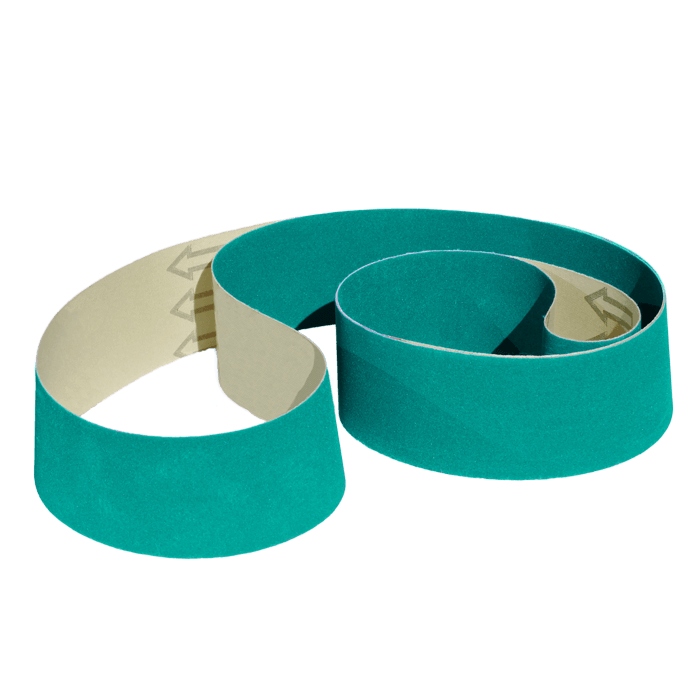
Zirconia grain is well suited to high pressure machining and grinding applications. Usually a blue color, these types of sanding belts are considerably tougher than aluminum oxide belts. In fact, they're usually around five times tougher than their aluminum oxide counterparts. Zirconia belts have one considerable advantage - they're self-sharpening (friable), which can save a ton of time for the user. The only downside to this is that they require a lot more force to sand things effectively, and as such, are best suited to surfaces like hardwood and metal that require heavy grinding. Zirconia sanding belts are mostly used in steel fabrication shops where they're the most popular choice for grinding and preparing metal.
Suitable For: Wood, Stainless Steel, Unalloyed Steel, Non Ferrous Metals such as Carbon Steel, Aluminum, Brass, Bronze, and Copper
Recommended Usage: Aggressive and heavy stock removal applications. Wet or dry sanding, depending on the backing material
Silicon Carbide Sanding Belts:
![]()
The natural form of silicon carbide is long, thin, and extremely sharp (nearly as sharp as diamond). It's fair to imagine these sanding belts as covered in tiny blades that get the job done quickly and efficiently. However, these belts have a major downside. The nature of the mineral used means that while they're extremely sharp, they're also more brittle than the other kinds of abrasive sanding belts, and as such break down at a much greater rate than other sanding belt choices. That doesn't mean that they don't work well, it just means that they work best in certain scenarios. For example, a narrow sanding belt for marble will get a perfect grind without much pressure, but they won't be the best choice for high pressure grinding something like steel. Silicon carbide is also commonly used to remove various coatings such as adhesives or paints and is the recommended abrasive for sanding glass.
Suitable For: Marble, Granite, Cement, Stone, Glass, Plastic, Composite, Rubber, Epoxy, Resin, Paint, Fiberglass, Non-Ferrous Metals
Recommended Usage: Sanding hard materials, achieving smooth finishes, and polishing. Wet or dry sanding, depending on the backing material
Ceramic Grit Sanding Belts:
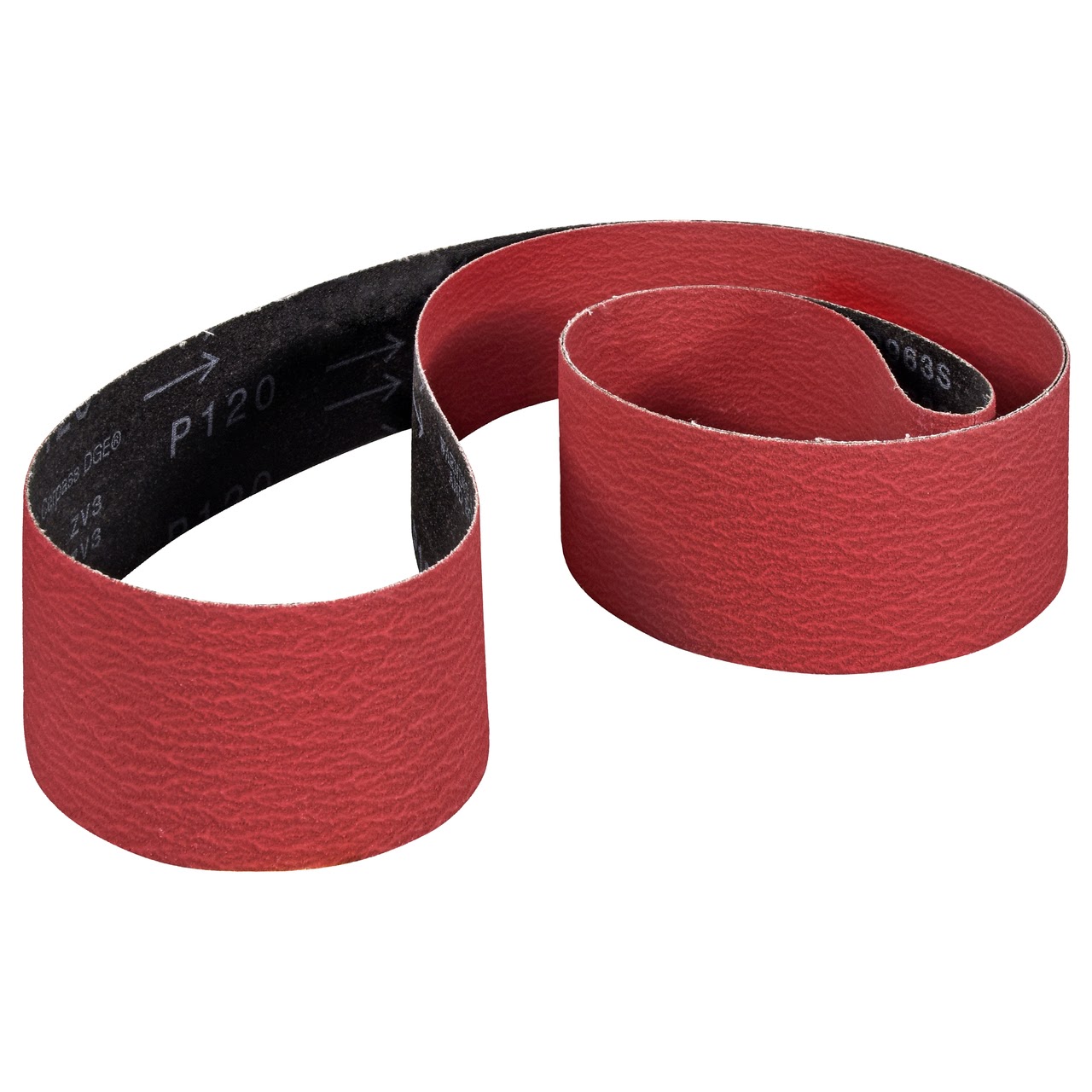
Ceramic abrasives are more uniform in structure than aluminum oxide and zirconia sanding belts. Much like Zirconia belts, they are self-sharpening, however they are also the coolest grinding, which is very important when working with heat sensitive materials. They're able to break down surfaces in a controlled manner which dramatically increases the number of available applications, and are by far the longest lasting belts. Ceramic grit sanding belts can be used on a number of metalwork tasks, including: finishing aluminum castings, finishing stainless steel, and even aerospace-grade titanium alloys. They are more expensive, but their higher performance and longevity often justifies the cost.
Suitable For: Super Alloys, Unalloyed Steel, Heat Sensitive Metals like Stainless Steel, Nickel and Cobalt, Aluminum and all Non Ferrous Metals including Copper, Brass, Gold, Silver, and Tin
Recommended Usage: Aggressive material removal, high-pressure applications, and when working on heat sensitive materials. Wet or dry sanding, depending on the backing material
Non-Woven/Surface Conditioning:
These belts are made with flexible non-woven, nylon mesh fibers, impregnated with abrasive grains. Their design reduces heat buildup and reduces the chance of damaging or discoloring the work material. Surface conditioning belts’ flexibility make them great for work around contours, edges, and irregular surfaces. They are used for light sanding, deburring, and finishing operations on a variety of materials.
Suitable For: All Metals, Wood, Paints and Coatings
Recommended Usage: Cleaning, deburring, surface conditioning, blending, and finishing applications. Commonly used on metal surfaces to remove rust, oxidation, and prepare surfaces for painting or coating.
Best Sanding Belts for Different Surface Materials
As you just read, each abrasive grain is capable of sanding and grinding different surfaces. These are the recommended grains for surfaces that sanding belts are often used on:
Wood
- For hardwoods: Any of the above mentioned abrasive grains will work well for sanding hardwoods like birch, cherry, mahogany, oak, maple, or ash.
- For softwoods: Sanding soft woods like cedar, fir, redwood, spruce, and pine will get the best results from aluminum oxide.
- For exotic or oily woods: Ceramic belts can be more effective due to their durability and heat-resistant properties.
Metal
- For ferrous metals (steel, iron): Zirconia or ceramic belts are ideal. Start with coarse grits (36-60) for heavy material removal, then progress to finer grits for finishing. For
- For non-ferrous metals (aluminum, brass): Silicon carbide belts work best. Use medium to fine grits (120-320) for most applications.
- For stainless steel: Ceramic belts offer the best performance due to their cool-cutting properties.
- For super alloys: You’re going to want ceramic.
Plastic
- Silicon carbide belts are generally best for plastics. Aluminum oxide can also be effective for harder plastics.
Floors
- For hardwood floors: Use aluminum oxide belts or zirc. Opt for ceramic floor sanding belts when dealing with pre-finished or exotic floors.
- For engineered concrete floors: Silicon carbide drum sander belts will be your go-to choice.
Glass and Stone
- Silicon carbide belts are best for these hard, brittle materials.
Remember, these are general guidelines. The specific requirements of your project, such as the condition of the material and the desired finish, may change these recommendations. Always start with a test area when working with a new material or belt type. For expert advice, our team is always available to chat.
Choosing the Right Belt Sander Grit
Getting the right grit size on your sanding belt is essential if you want to complete the job successfully. The grit size of a sanding belt is based on the size of the abrasive grains on the belt. It determines how coarse or fine the abrasives are. The heavier the job, the coarser the sanding belt you'll need. 40 to 60 grit is best suited for the heaviest work. When you're performing tasks such as smoothing surfaces or removing minor blemishes, you're better off using sandpaper with 80 to 120 grit. For the end of a job, when you're finishing surfaces, a fine sandpaper with 350 to 600 grit is the ideal choice.
- Coarse grits remove material quickly but leave a rough surface.
- Medium grits smooth out the scratches left by coarse grits.
- Fine grits begin to create a smooth surface.
- Very fine grits are used for final smoothing and polishing.
Approximate Grit Ranges:
- Extra Coarse: 24-36 grit
- Coarse: 40-60 grit
- Medium: 80-120 grit
- Fine: 150-240 grit
- Very Fine: 320-400 grit
- Extra Fine/Super Fine: 600+
Grit Progression
It's likely that you'll have to use a number of different grits when working on a job, starting with a lower-grade grit before working your way through to super-fine pieces of sandpaper as you progress through the task. When you move to a higher grit of sandpaper you remove scuffs and scratches left behind from the previous layer.
Grit Progression for Different Materials
Wood*: 60 → 80 → 120 → 150 → 220
Metal: 40/60 → 80 → 120 → 240 → 400
Plastic: 80 → 120 → 220 → 320 → 600
*Hardwoods can start with a slightly more coarse grit than softwoods.
Sanding Belt Sizes and Compatibility
Once you’ve selected your abrasive grain and grit, the hard decisions are pretty much done. If you have a belt sander already, you basically just have to match the size of the belt to your machine’s specs.
If you're unsure what size you need, we put together this guide of easy methods to figuring out the right sanding belt size for your machine.
There are many different sizes available, with the below being some of the most common sizes for sanding belt machines.
- Handheld/Portable Belt Sanders:
- Bench-mounted Sanders:
- Floor Sanders:
- 8" x 19-1/4"
- 8" x 29-1/2"
Custom Sanding Belt Sizes for Specialized Applications
For unique or specialized applications, custom-sized sanding belts can be made. Custom sizes can be tailored to fit non-standard machines or to meet specific project requirements. If you’re in need of custom sanding belts, reach out to Empire Abrasives by phone, email, or online chat to get a free quote.
The Five Common Types of Belt Sanding Machines
The five most common types of machines you’ll use a sanding belt on are hand powered belt sanders, tube belt sanders, belt file sanders, floor sanders and stationary sanding belt grinders. Each machine serves a special purpose for their specific jobs.
Hand Powered Belt Sander
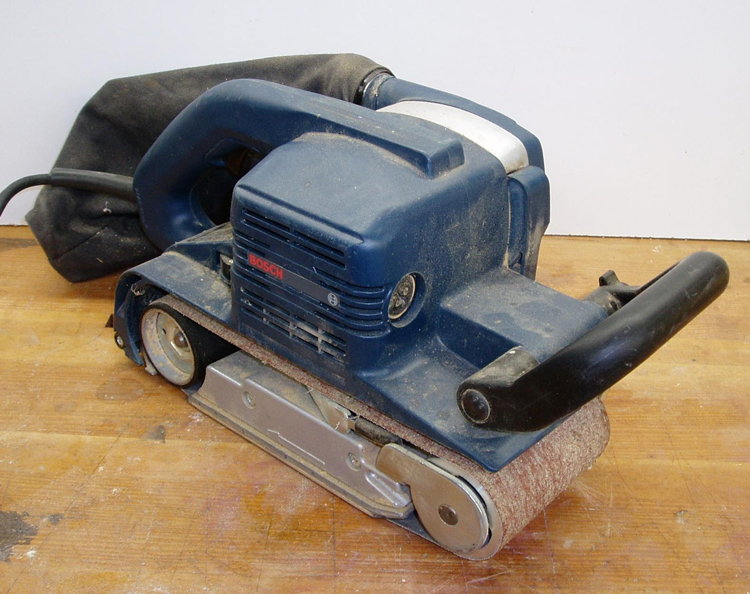
Corded and battery powered hand sanders are one of the most popular tools among woodworkers, homeowners and DIYers. Many units feature variable speeds and dust collectors making them even more versatile. These portable sanders work well on small project pieces or large spaces like decks to smooth out and finish surfaces. The most common sized belts used on Hand Sanders are 3” x 21”, 3” x 18” and 4” x 24" sanding belts.
Tube Belt Sanders
Tube belt sanders aka Pipe Polishers are machines consisting of a pulley system that allows the sanding belt to contour around tube shaped surfaces. The machines are typically handheld and electrically powered.
Belt File Sanders

Belt file sanders are usually handheld sanding machines that make use of narrow, small sanding belts. These machines are great for fitting into tight work spaces or removing welds from inside corners. Common sized include 1/2" x 18", 3/8" x 13" and 1/2" X 24".
Floor Belt Sanders

Floor belt sanders are mobile sanding machines that are manually pushed by the operator to effectively sand wood floors. These floor drum sanders allow larger jobs to be finished quickly, while often utilizing smaller tools to properly sand the edges (such as Edger Disc Sanders). Common sizes of floor sanding belts include 8” x 19”, and 7-⅞” x 29-½”.
Stationary Belt Grinders
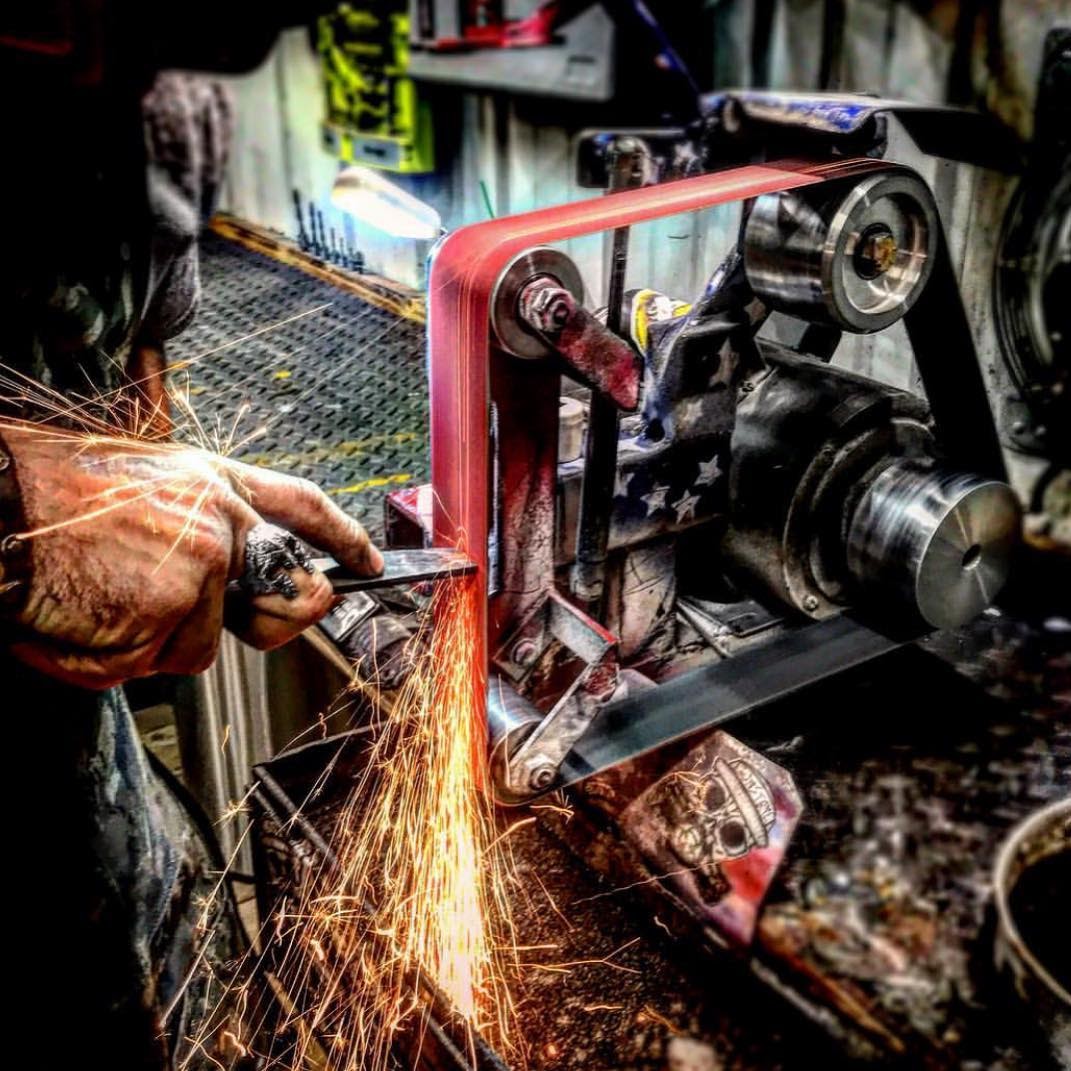
Stationary Belt Grinders can be bench mounted, pedestal mounted or even large machines with their own stands. These machines are designed in many different ways and use various sized belts depending on the application. Many of these are used in niche fabrication shops or large manufacturing facilities. Most popular sizes include 1"x30", 2" x 72", 4" x 36", and 6" x 48".
Often these machines have a built-in disc sander that utilizes the same motor as the belt pulley. These types of machines are commonly referred to as combo belt grinders and very popular among knife making enthusiasts.
Common Mistakes to Avoid When Choosing Sanding Belts
- Choosing based on price alone: Cheaper belts usually don’t last as long or perform as well as quality belts.
- Ignoring the importance of grit progression: Skipping or rushing through a grit progression will most likely lead to a poor finish.
- Using the wrong abrasive for the material: Different materials require specific abrasives for the best results.
- Installing a Uni-directional belt wrong: Always check the directional arrows on the belt for proper installation (note: Empire Abrasives only sells bi-directional belts).
Tips for Using Your Sanding Belt
- Keep your sanding belt clean. When material loads onto your sanding belt, the belt’s effectiveness is dramatically decreased. A grease stick can be applied to the belt before use with metal or a rubber belt sander cleaner stick can be used to remove any loaded materials.
- Protect yourself. Wearing safety glasses or a face shield is a good idea, as well as a respirator for dusty operations.
- Inspect your sander. Be sure that the drive drum/wheel/roller has no divots or bumps, else there will be uneven sanding across the belt.
- When using a power hand sander ensure what you are working on is solidly clamped and unable to move. A loose surface means that you'll end up with a non-linear pattern and have to redo it.
- Adjust the speed of your belt according to the job at hand. Lower speeds give you greater maneuverability, whereas a higher speed gives you the ability to cover a greater surface area with minimal effort.
- A pencil is your best friend when sanding. Marking guidelines on the surface can give you handy visual clues on your sanding process. It can also help you to show where you need additional sanding.
- Never sand from side to side, always go from forwards to backwards. This can prevent the belt from skidding and almost completely eliminates the risk of damage to the belt and the sanding machine.
Speak with an Abrasives Expert
Choosing the right sanding belt can significantly impact the quality of your project. Consider the material, desired finish, grit progression, and abrasive type to achieve the best results. If you're still unsure, don't hesitate to reach out to our experts at Empire Abrasives. We're happy to help you find the perfect sanding belt for your specific needs. TOLL FREE 800-816-3824
Don't settle for less than professional results. Equip yourself with Empire Abrasives' top-quality sanding belts, shipped within 1 business day to keep your projects on track. Order today!
Sanding Belt FAQs
Q: What is the best sanding belt for metal?
A: Ceramic belts are typically the best choice due to their durability and fast cutting ability. That being said, the best sanding belt for metal ultimately depends on the specific type of metal you're working with, the desired finish, and the intensity of sanding required. Zirconia alumina is a good alternative for tougher metals and high-pressure sanding, while aluminum oxide can be suitable for lighter sanding on softer metals.
Q: How do I know when to replace my sanding belt?
A: Replace the belt when it shows signs of wear, tears, or if it’s no longer sanding effectively.
Q: What's the difference between open coat and closed coat sanding belts?
A: Open coat belts have more space between abrasive grains. This reduces clogging and heat buildup. The abrasives in a closed coat belt are more densely packed, which is great for aggressive cutting, but can clog/load easier.
Q: How do I clean my sanding belt?
A: Use a sanding belt cleaning stick or rubber cleaning block to remove debris. Just press the cleaner against the moving belt to dislodge particles.
Q: What’s the point of an abrasive grease stick?
A: Abrasive grease sticks reduce heat buildup and prevent clogging, especially during heavy sanding tasks. They also extend the life of the sanding belt and improve its performance.
Additional Resources:
- Silicon Carbide vs Aluminum Oxide Abrasives
- Ceramic vs. Zirconia Abrasives: Which is the Best Option?
- How to Clean Sanding Belts and Tips to Extend Belt Life
- Troubleshooting Common Abrasive Tool Issues - Sanding Belts
- Sandpaper Grit Explained
- Safety Tips for Using Sanding Belts

